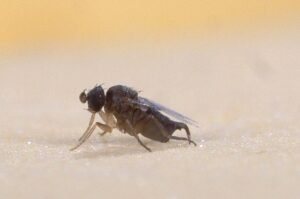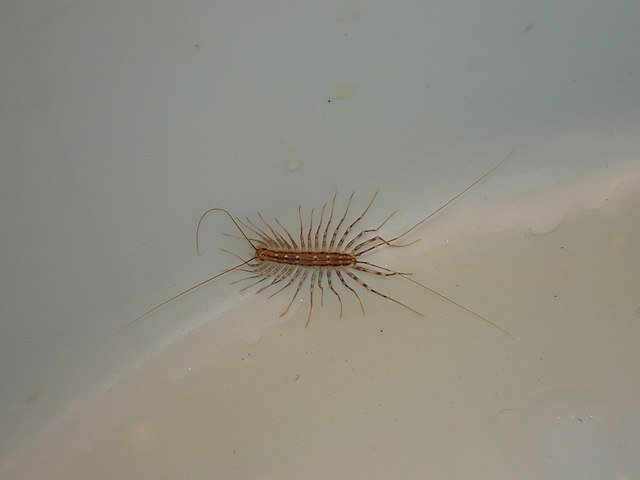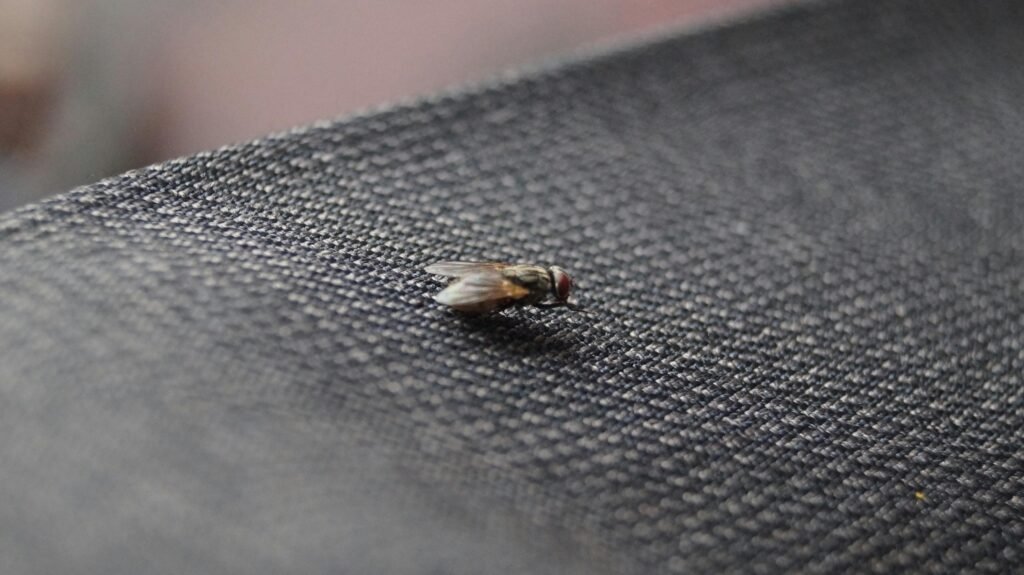Phorid Flies (Phoridae): The Humpbacked Pests of Homes and Hospitals
 The Phorid Flies (Phoridae), also known as humpbacked flies, are small, dark-colored insects that thrive in moist, decaying organic material. Unlike Drain Flies (Psychodidae), which are associated with slimy drains, or Fungus Gnats (Sciaridae), which hover around potted plants, phorid flies are notorious for breeding in hidden, unsanitary environments such as sewage leaks, rotting food, and even hospital waste.
The Phorid Flies (Phoridae), also known as humpbacked flies, are small, dark-colored insects that thrive in moist, decaying organic material. Unlike Drain Flies (Psychodidae), which are associated with slimy drains, or Fungus Gnats (Sciaridae), which hover around potted plants, phorid flies are notorious for breeding in hidden, unsanitary environments such as sewage leaks, rotting food, and even hospital waste.
What makes them particularly concerning is not just their persistence indoors but also their strong association with healthcare settings, where they can pose contamination risks. Their distinctive humpbacked appearance and jerky running movements on surfaces help distinguish them from Fruit Flies (Drosophilidae) and other small flies.
This guide explores the biology, identification, habits, risks, and control of phorid flies, with insights into why they are among the most persistent and troubling indoor fly pests.
Identification
Size: 0.5–5 mm, usually on the smaller end.
Coloration: Tan to dark brown, often with a characteristic humpbacked thorax.
Behavior: Instead of flying smoothly like House Flies (Musca domestica), they tend to run rapidly in short bursts across surfaces.
Wings: Veins are reduced; wings appear clear and held flat.
Habitat clues: Commonly spotted near garbage areas, bathroom drains, leaking pipes, or contaminated medical equipment in hospitals.
Field Tip: If you see a small fly that runs quickly across a counter before taking off, it’s more likely a phorid fly than a fruit fly.
Biology and Lifecycle
Eggs: Laid in moist, organic matter such as rotting food, sewage, or carcasses.
Larvae: Known to survive in extreme, foul conditions. They are small, whitish maggots.
Pupation: Occurs near breeding sites; pupae may migrate away from the source.
Adults: Emerge within 2–4 weeks depending on conditions.
Reproduction: Females can lay hundreds of eggs in their lifetime.
Unlike Case-Bearing Clothes Moths (Tinea pellionella), which feed on textiles, phorid larvae are primarily decomposers, thriving in decaying organic matter.
Ecology and Distribution
Global spread: Found worldwide in both temperate and tropical regions.
Indoors: Hospitals, restaurants, food storage facilities, bathrooms, and drains.
Outdoors: Compost piles, animal manure, garbage dumps.
Adaptability: Can breed in places inaccessible to most other flies, such as broken sewage lines beneath floors or inside wall voids.
In healthcare facilities, their presence is especially alarming because of their potential to spread pathogens from contaminated waste to sterile areas.
Risks and Public Health Concerns
Vector potential: Though not proven major disease vectors like cockroaches or mosquitoes, phorid flies have been found carrying bacteria such as E. coli and Salmonella.
Hospitals: Documented cases show phorid flies contaminating surgical environments, feeding on medical waste, and even colonizing human wounds.
Food industry: Their presence signals severe hygiene issues and can lead to regulatory penalties.
Psychological impact: The sight of swarms in kitchens or healthcare settings creates strong perceptions of filth.
Signs of Infestation
Small, dark flies running across surfaces before flying.
Clusters near garbage, drains, or sewage leaks.
Infestations that persist even after cleaning—indicating hidden breeding sources.
In hospitals, detection near medical waste or drain traps is a red flag.
Household and Commercial Control
Inspection:
Identify breeding sources, which may be hidden beneath tiles, inside wall voids, or under floors where sewage leaks exist.
Sanitation:
Eliminate all sources of organic matter (garbage, spilled food, grease traps).
Repair leaking pipes and drains immediately.
Exclusion:
Seal cracks and crevices where flies may breed or emerge.
Install proper drain covers and screens.
Mechanical cleaning:
Flush drains with enzyme-based cleaners instead of bleach (similar to control for drain flies).
Moisture management:
Use dehumidifiers in problem areas to reduce humidity levels.
Professional and Long-Term Control
IPM (Integrated Pest Management): Effective phorid fly control starts with eliminating breeding sites. Pesticide fogging alone will not resolve the problem.
Biological considerations: In rare cases, natural enemies like predatory mites can affect larvae, but this is not practical indoors.
Chemical control: Residual sprays or aerosols may provide temporary relief, but long-term success requires solving sanitation and plumbing issues.
Monitoring: Sticky traps help confirm presence and track populations but do not solve infestations.
In severe infestations, especially in hospitals or food industries, professional pest management is essential.
Final Thoughts
Phorid flies (Phoridae) represent one of the most persistent small fly problems indoors. Unlike Fruit Flies or Fungus Gnats, which can be traced back to exposed food or damp plant soil, phorid flies often point to deeper structural or sanitation issues, such as broken sewage lines or hidden organic decay.
Their ability to exploit concealed breeding grounds makes them exceptionally difficult to eliminate without thorough investigation. For households, this may mean pulling up tiles or repairing pipes; for commercial facilities, it often requires coordinated sanitation protocols and pest management.
While phorid flies are unlikely to cause direct harm through bites or stings—unlike mosquitoes or spiders—their role as mechanical carriers of pathogens should not be underestimated, particularly in healthcare settings. In fact, their presence indoors should always be interpreted as a red flag that something more serious may be brewing below the surface.
Ultimately, the best defense against phorid flies is vigilance: consistent cleaning, prompt repairs of plumbing issues, and professional intervention when infestations persist.
FAQs About Phorid Flies
Q: How can I tell phorid flies apart from fruit flies?
A: Phorid flies have a distinct humpbacked appearance and run rapidly on surfaces before flying. Fruit flies are more rounded and hover around fruit or fermenting liquids.
Q: Where do phorid flies come from in hospitals?
A: They often breed in drain traps, sewage leaks, and contaminated waste. Their presence indoors signals sanitation or plumbing issues.
Q: Do phorid flies bite?
A: No, they do not bite humans. Their risk lies in contaminating surfaces with bacteria.
Q: Why are phorid flies considered dangerous in medical settings?
A: They have been found carrying bacteria such as Salmonella and E. coli. In rare cases, larvae have even been documented colonizing open wounds.
Q: What is the fastest way to get rid of them?
A: There is no quick fix—long-term control requires identifying and eliminating breeding sources. Pesticide sprays only offer temporary relief.
Disclaimer
This article is for informational purposes only. Pest control laws and approved chemicals vary by country. For best results and legal safety, we strongly recommend contacting a licensed pest control professional in your local area. Always make sure that the pest control technician is properly certified or licensed, depending on your country’s regulations. It’s important to confirm that they only use approved products and apply them exactly as instructed on the product label. In most places in Europe, UK, or USA, following label directions is not just best practice—it’s the law.
Author
Nasos Iliopoulos
MSc Agronomist & Certified Pest Control Expert
Scientific Director, Advance Services (Athens, Greece)
Licensed Pest Control Business – Ministry of Rural Development & Food (GR)
References
Wikipedia – Phorid Flies
Penn State Extension – Phorid Flies


